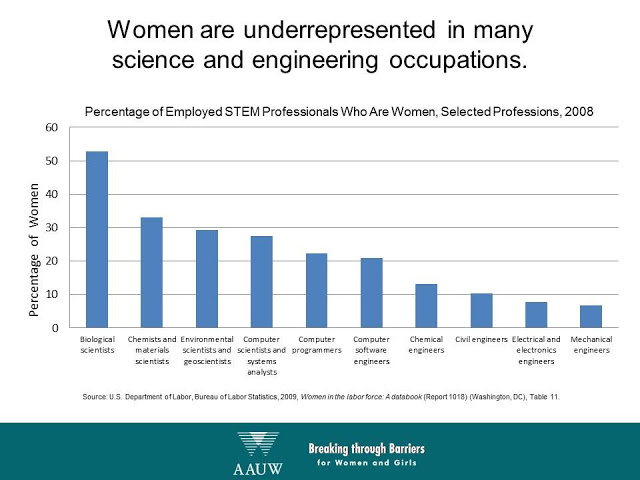Astronomy


- Why So Few? Spatial Skills
The 2010 report entitled, Why So Few? Women in Science, Technology, Engineering, and Mathematics, by the American Association of University Women (AAUW), investigates the area of spatial skills learning. One of the largest and most persistent gender gaps...
- Uk's 'your Life' Campaign: Government, Industry, And Universities' Concrete Steps To Recruiting Women In Stem
In early May the UK launched its ?Your Life? campaign, a new STEM initiative focused on spreading the message that science and math are the pathway to a successful and well-paid career*. The initiatives concrete goals are to:Increase the total number...
- Are Stem Programs Effective?
Since graduate school, when the issues facing women in STEM first became apparent to me, I?ve been involved in several programs that seek to increase the number of women in STEM majors and career fields; most of these programs focus on K12 female students. ...
- Top 5 Myths About Girls, Math, And Science
LiveScience debunks the top 5 myths about girls, math, and science: The days of sexist science teachers and Barbies chirping that "math class is tough!" are over, according to pop culture, but a government program aimed at bringing more women and girls...
- The Status Of Mit Women Faculty In Science And Engineering
[Note: This is a copy of a post at diversity.mit.edu.] MIT has just released an important new report, A Report on the Status of Women Faculty in the Schools of Science and Engineering at MIT, 2011. This report, prepared in association with the upcoming...
Astronomy
Why So Few? Scientific Workforce

The 2010 report entitled, Why So Few? Women in Science, Technology, Engineering, and Mathematics, by the American Association of University Women (AAUW), finds that women?s representation in the STEM workforce is uneven. This graph shows the percentage of women in selected STEM occupations between 1960 and 2000. In general, women?s overall representation has increased in all these occupations since the 1960s; however, in 2000, although women were well represented among biological scientists, for instance, they made up a small minority of engineers. These data come from the census, so the most recent data available are from 2000. Also, the definitions of the different occupations have changed slightly with each census.

More recent data, from the Bureau of Labor Statistics, show a similar pattern. This graph shows the percentage of employed STEM professionals who are women in selected fields. While women made up more than half of biological scientists in 2008, they accounted for less than 7% of mechanical engineers. So although the trends for girls? and women?s participation and performance in STEM fields are positive, women remain underrepresented in certain STEM fields, and it is important that we continue to pay attention to this issue. Why? The two main reasons are for equity and for innovation.
With respect to equity, STEM fields are high-growth fields. Many science and engineering occupations are predicted to grow faster than the average rate for all occupations over the next decade. Some of the largest increases will be in engineering- and computer-related fields?fields in which women currently hold one-quarter or less of the positions. When women aren?t in these fields, they lose out on the job and financial security that these high-growth, high-pay fields provide. In addition, occupational segregation accounts for the majority of the gender wage gap, and although women still earn less than men earn in science and engineering fields, the more women have access to jobs in these fields (many of which remain predominantly male), the greater the likelihood that the gender pay gap will shrink as occupational segregation decreases.
With respect to innovation, a more diverse workforce contributes to innovation. People from different backgrounds enhance the productivity of design and research teams by bringing together different viewpoints and experiences, and therefore, scientific and technological products, services, and solutions are likely to be better designed and more likely to represent all users. For example, when airbags were first introduced, they were designed by a predominantly male team, and although these airbags protected men in accidents, they resulted in avoidable deaths for women and children. Arguably, if more women had been on the team that designed these earliest airbags, they may have been better designed to protect women and children as well as men.
Note: much of this text is from the AAUW ppt describing highlights of the Why So Few? report.
- Why So Few? Spatial Skills
The 2010 report entitled, Why So Few? Women in Science, Technology, Engineering, and Mathematics, by the American Association of University Women (AAUW), investigates the area of spatial skills learning. One of the largest and most persistent gender gaps...
- Uk's 'your Life' Campaign: Government, Industry, And Universities' Concrete Steps To Recruiting Women In Stem
In early May the UK launched its ?Your Life? campaign, a new STEM initiative focused on spreading the message that science and math are the pathway to a successful and well-paid career*. The initiatives concrete goals are to:Increase the total number...
- Are Stem Programs Effective?
Since graduate school, when the issues facing women in STEM first became apparent to me, I?ve been involved in several programs that seek to increase the number of women in STEM majors and career fields; most of these programs focus on K12 female students. ...
- Top 5 Myths About Girls, Math, And Science
LiveScience debunks the top 5 myths about girls, math, and science: The days of sexist science teachers and Barbies chirping that "math class is tough!" are over, according to pop culture, but a government program aimed at bringing more women and girls...
- The Status Of Mit Women Faculty In Science And Engineering
[Note: This is a copy of a post at diversity.mit.edu.] MIT has just released an important new report, A Report on the Status of Women Faculty in the Schools of Science and Engineering at MIT, 2011. This report, prepared in association with the upcoming...
